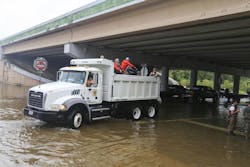The broad devastation wrought by hurricanes Harvey, Irma, and Nate include severe flooding for many southern portions of the U.S. – flooding that often involved sea water. And the salt in the sea water can be harmful long term to truck and trailer components, warns Jim Szudy, engineering manager for advanced systems engineering at Bendix Commercial Vehicle Systems LLC. In this guest column, he offers maintenance and repair advice to counteract the potential damage flooding can cause for fleets.
In countless ways, this hurricane season’s extensive and severe flooding has been devastating for people and property. With truck drivers and the trucking industry so vital to the recovery and rebuilding efforts in these areas, it’s important to keep tractors and trailers in safe operating condition and help avoid future issues if they’ve been exposed to floodwaters.
At the top of the list is the question of whether the floodwater was salt water. If the answer is yes, then you should immediately begin replacing parts. Pneumatic air brake valves that have been submerged have likely lost their lubrication, for example.
When exposed to the extremely corrosive nature of salt water, those valves would be at much higher risk for sudden and premature malfunction.
Any brake system valve that’s been submerged in sea water should be replaced, along with air compressors, air reservoirs, antilock brake system (ABS) relay modulators, and brake actuators.
Salt water also heightens the possibility of corrosion at the wheel-ends, leading to increased chances of rust-jacking and damage to other components. Again, we recommend complete replacement to prevent future failure.If the vehicle was in a coastal area, and it’s not clear whether the water submergence was by fresh water or salt water, it’s best to play things safe and follow the above guidelines.
Additionally, during the replacement of any pneumatic system components that have been subjected to flood conditions, all contaminated air hoses should be disconnected, flushed with clean water, and blown out with air pressure to remove contaminants.
If it’s certain the vehicle or trailer got submerged in fresh water, power wash the vehicle and trailer, including the foundation brakes, to assist in determining the condition of components. Then take the following steps to properly check the air brake control systems.
Vehicle valves:
- To check for evidence of water or contamination, mark and remove the connectors at the first valve in the system from the front
- Inspect the valve for water and contaminants, and carefully use air pressure to blow air through the hoses and watch for evidence of water or contamination.
- Continue to inspect all the valves in the air brake system, removing one service and control hose from each to inspect. Replace any non-functioning valves.
The charging system:
- When fresh water has entered the air compressor or dryer through the air system intakes, do not attempt to start the vehicle.
- Use dry compressed air from a stationary (or suitable portable unit) air compressor to drain the service tanks of any residual water. Air dryers remove moisture in compressed air, but they won’t remove moisture that’s present after the service tanks.
- After pneumatic lines are reconnected, install a new or properly serviced air dryer to aid in removing any residual moisture from the air inlet.
Wheel-ends:
- Examine wheel-ends for water, which increases the possibility of rust-jacking (corrosion between lining material and the shoe table) on drum brakes, and can also pool in drums when left standing, leading to corrosion.
- Ensure the integrity of the friction coupling between the friction and disc or drum.
- Verify no water has entered the chamber through the airlines by removing fittings and mounting stud nuts and orient ports down. If present, drain and reinstall. Follow the appropriate wheel-end re-lubrication procedures, including re-greasing slack adjusters.
Electronics system:
- Conduct a diagnostic download for both the ABS and stability control system (if your vehicle is equipped with one) controllers.
- In most cases, electronics will validate through self-check. If the electronic control unit (ECU) is operable, it will check the necessary solenoids, sensor, harnesses, etc.
- Inspect the seven-pin electrical connector interface between the tractor and trailer.
- Inspect tractor and trailer glad hands and the supply and control hoses, since water and contaminants can pass into the air brake system through unprotected glad hands.
Given the importance of a fully functioning system and clean air, it’s necessary to replace all pneumatic air brake components if you find signs of moisture or other contamination, just as you would in the case of salt water submersion.”
If no evidence of water or contamination is found, thoroughly test the air brake system and ABS before returning the vehicle or trailer to service. Also, where the ABS is concerned, the action of floodwaters and power washing may move the ABS wheel speed sensors from their normal position. By hand, push the wheel speed sensors back into contact with the exciter ring, and normal wheel bearing play will adjust the sensor position when the wheel turns.
We recommend re-testing – including diagnostic checks of electronic systems such as ABS, full stability (ESP/ESC), collision mitigation systems, and Automatic Traction Control (ATC) – 30 days after the vehicle or trailer has been returned to service.
And keep in mind that other vehicle systems may be impacted by flooding as well, so make sure you’re following all the appropriate vehicle and system manufacturer inspection guidelines.


